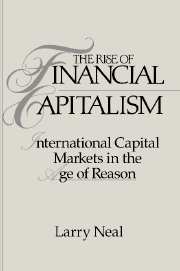Book contents
- Frontmatter
- Contents
- Acknowledgments
- 1 Historical background for the rise of financial capitalism: commercial revolution, rise of nation-states, and capital markets
- 2 The development of an information network and the international capital market of London and Amsterdam
- 3 The early capital markets of London and Amsterdam
- 4 The Banque Royale and the South Sea Company: how the bubbles began
- 5 The Bank of England and the South Sea Company: how the bubbles ended
- 6 The English and Dutch East Indies companies: how the East was won
- 7 The integration of the English and Dutch capital markets in peace and war
- 8 The English and Dutch capital markets in panics
- 9 The capital markets during revolutions, war, and peace
- 10 A tale of two revolutions: international capital flows, 1792–1815
- 11 The Amsterdam and London stock markets, 1800–25
- Appendix End-of-month share prices
- Bibliography
- Index
8 - The English and Dutch capital markets in panics
Published online by Cambridge University Press: 25 March 2010
- Frontmatter
- Contents
- Acknowledgments
- 1 Historical background for the rise of financial capitalism: commercial revolution, rise of nation-states, and capital markets
- 2 The development of an information network and the international capital market of London and Amsterdam
- 3 The early capital markets of London and Amsterdam
- 4 The Banque Royale and the South Sea Company: how the bubbles began
- 5 The Bank of England and the South Sea Company: how the bubbles ended
- 6 The English and Dutch East Indies companies: how the East was won
- 7 The integration of the English and Dutch capital markets in peace and war
- 8 The English and Dutch capital markets in panics
- 9 The capital markets during revolutions, war, and peace
- 10 A tale of two revolutions: international capital flows, 1792–1815
- 11 The Amsterdam and London stock markets, 1800–25
- Appendix End-of-month share prices
- Bibliography
- Index
Summary
Measuring the degree of integration in financial markets is difficult both theoretically and empirically. The theoretical difficulties are well illustrated in the literature dealing with U.S. capital markets in the late nineteenth century. This literature takes advantage of the plentiful data that can be found for regional interest rates, but it confronts an inherent theoretical problem by trying to measure an economic phenomenon – integration of capital markets – with a variable measuring rod. The measuring rod, the short-term interest rates earned by banks on a broad class of loans, must vary as local regulations vary, as the riskiness and duration of the loans within the category vary, and as monopoly rents vary. All these variations must be allowed for if a consistent measuring instrument is to be obtained. If they are not, then the possibility always remains that divergences or convergences of interest rates between two capital markets may be due to factors other than integration or separation of the two markets. These difficulties of interpretation are inherent in the use of the interest-rate arbitrage model to derive a measuring standard.
In this chapter we can take advantage of the price series developed in the preceding chapter to measure the difference in the prices of a share of stock as quoted on the same day in the domestic exchange for the company and in a foreign exchange. Fritz Machlup referred to this as the simplest test of all for market integration, because the product is standardized, identical in the two markets, and the cost of transport between the two markets is essentially zero.
- Type
- Chapter
- Information
- The Rise of Financial CapitalismInternational Capital Markets in the Age of Reason, pp. 166 - 179Publisher: Cambridge University PressPrint publication year: 1991



